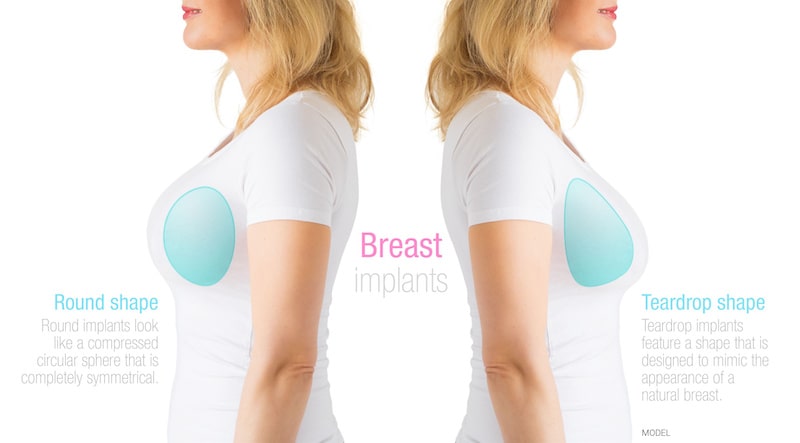Breast Augmentation, Breast Implants
4 Minute Read:
Year after year, breast augmentation remains one of the most popular plastic surgery procedures chosen by women worldwide. This breast enhancement option enlarges the breasts and improves symmetry for women with naturally small breasts or who experience breast deflation after pregnancy, weight loss, or normal aging.
While some women can increase the size of their breasts using fat transfer or fat grafting (often referred to as natural breast augmentation), the vast majority of women who want to enlarge their breasts do so with breast implants.
What Are Breast Implants?
At their most basic level, breast implants are filled “sacs” that are inserted into a created breast pocket either above or below the pectoral muscles in both breasts. In rare asymmetry situations, an implant may only be added to one breast to balance out the chest.
The shells of these implants are always made of medical-grade silicone; however, the filling materials vary depending on your breast augmentation goals.
Modern implants are filled with saline or silicone; however, even that choice is more complex than it sounds.
Understanding Saline Implants
Saline implants are a common choice for women looking to noticeably enhance their breast fullness.
These implants are filled with a sterile saline solution (encased by a silicone shell) and have been popular for the last several decades. These were also exclusively offered in the late 90s and early 2000s when silicone implants were temporarily banned.
*Safety concerns associated with silicone implants that led to the decade-long ban have been disproven, and there is little difference between the safety of saline and silicone implants today.
Saline implants (like all implants) have their pros and cons.
One of the benefits of saline implants is that they require a much smaller incision because saline implants are not filled until after they are placed in the breast pocket. The surgeon inserts an empty silicone shell and inflates it to the desired fullness.
Additionally, should a saline rupture occur (which is rare), it is easily noticeable because the saline is quickly — and safely — absorbed by the body. Saline implants also have a smaller capsular contracture rate (an uncomfortable implant complication that requires breast revision surgery).
While these factors are significant, saline implants are not without complications. Because of the filling material, saline implants are more prone to breast rippling (when the shell of the implant can be seen through the breast skin. Saline implants are also considered to look less natural than silicone implants.
That said, some women desire the round, upper-pole fullness provided by saline implants. It all comes down to personal preference.
Understanding Silicone Implants
While all silicone implants are filled with a silicone gel, the cohesiveness (thickness) of that gel varies.
Traditional silicone implants: Modern silicone implants contain a cohesive silicone gel that will retain its shape and remain in the capsule even in the event of a rupture. These implants are often round in form and provide a natural look and feel to the breast.
- Gummy bear implants: Gummy bear implants consist of a thicker, more form-stable silicone gel. These implants are often teardrop-shaped (anatomically shaped) to mimic the slope of natural breast tissue.
While there is no “right” implant, many plastic surgeons and patients prefer silicone over saline implants. Be sure to discuss your options with your surgeon during your consultation.
Determining Implant Shape and Profile
You can choose a round implant or a teardrop-shaped implant. Much like their names suggest, round implants are spherical, providing equal fullness to the upper and lower portions of the breasts; anatomical implants give more fullness to the lower pole of the breast.
Shaped implants often have a rough surface texture to prevent them from rotating in the breast — disturbing the breast aesthetic.

Implants are also separated by breast profile. The right profile for you will largely depend on your physical build, as this represents the base diameter of the implant.
- Low profile implants have a wider base and are designed for taller women with broader shoulders. These implants tend not to project as far off the chest because of their base diameter.
- High profile implants have a narrow base diameter but project the furthest from the chest. These implants are best for petite women with smaller chest walls.
- Moderate profile implants have a narrower base than a low profile implant but a wider base than a high profile implant. These implants are usually ideal for most average-sized women.
Evaluating Implant Size
After your consultation, you and your board-certified plastic surgeon will determine the right implant size for you, considering both your aesthetic desires and physical build.
Implants are measured in CCs (not cup sizes) and are highly customizable.
Interested in Breast Augmentation in San Diego, CA?
If you are ready to schedule a breast augmentation in San Diego, call the expert team at Coastal Plastic Surgeons at (858) 365-3558. You can also fill out our online contact form.
